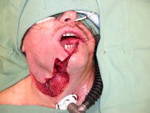Addiction to Smokeless Tobacco in America

According to the Federal Trade Commission report of 2012, smokeless tobacco sales in the United States alone, amounted to about 2.8 billion dollars for the year of 2008. The sales are robust and increasing due in some part to the decline of cigarette smoking. Then too, smokeless tobacco companies spend millions upon millions to attract new users.
The obvious target is the youth of America. The tobacco industry is very much aware of their vulnerability so they focus on large attendance venues where the impressionable youth gather. So, sporting events, hunting shows, race-tracks and such become high-stake promotional grounds, killing fields on an extended-release schedule, if you please.
Almost like those who wear military medals, this is also where you will find the older smokeless tobacco users, showing off their badges of macho-ism, the tell-tale worn, circular pattern on the back pocket of their jeans and the ubiquitous spit-cup.
The most horrible aspect of the smokeless tobacco scene is when a young teenage boy becomes addicted. By the time the dipping act has progressed to the health-impact stage the boy has become a man, a man who has provided of many years of years of cash flow for the tobacco companies who, of course, deny any connection of their products and the debilitating consequences.
Once addicted, several things are set into motion; all is well for a while, sometimes for years. The sensations of addiction are compelling, the sub-conscious pleads for satiation and the sweet moist brown pinch does its job, but alas, the fix is short-lived. Repetitive action displaces rational thought. Then one day you notice a red spot on the inside of your cheek. The following is a short story of what has happened:
Alkaloid nicotine equals addiction.
Tobacco leaf to be made into snuff can be smoke-cured for 3 days to 10 weeks.
Wood smoke is an excellent source of methanol thus,
Snuff can be heavily saturated with methanol.
When such snuff is dipped, the methanol component is deposited in the oral cavity.
Methanol is then free to combine with the ADH (alcohol-dehydrogenase) enzyme.
When ADH combines with methanol the by-product is formaldehyde.Formaldehyde immediately attacks the first healthy cells wherever it makes contact.
If snuff is inhaled formaldehyde weakens the cells in the nasal passages.
If snuff is dipped formaldehyde weakens the cells in the oral cavity, gums or jaw bones.
Over time, the probable result is cancer in the nasal passages or oral cavity.
Formaldehyde is also the prime cause of Alzheimer’s, MS and heart problems. [1]
The United States was the last civilized and industrial nation to declare formaldehyde a carcinogen. This action of the U.S. Department of Health and Human Services took place on June 10, 2011. [2]
That act alone offers some affirmation of the theory developed by Woodrow C. Monte, Professor Emeritus of Food Science and Nutrition at Arizona State University. Recognizing the potential liability and concerns for their customer base, Johnson & Johnson has pledged to remove formaldehyde from its baby-shampoo by 2013. [3]
Printed government warnings on products which contain the deadly toxins that can come in contact with human tissues are easily ignored but the World Health Organization says that pictures are the most powerful means of fighting the global epidemic.
Everyone has the choice; you can live a life of repeated little short pleasure-periods but a life of fear and uncertainty brought on by addiction or, you can take a defensive stand to protect the strength and integrity of your body. Hopefully, it won’t be too late to escape the tentacles of the demon.
“Come on cowboy, you can do it; toss away that shiny little twist-off snuff container!”
Charles Foerster is a former Naval Aviator and professional pilot, E-mail: [email protected]
Notes
[1] “While Science Sleeps” website, Woodrow C. Monte, PhD.
http://www.whilesciencesleeps.com/
[2] www.osha.gov/SLTC/formaldehyde
[3] NY Times article, Johnson &Johnson to remove formaldehyde from baby shampoo:
http://www.nytimes.com/2012/08/16/business/johnson-johnson-to-remove-formaldehyde-from-products.html
[4] Photo credits: Curtis Ansley, http://www.outdoortexan.com/mycancer.htm

